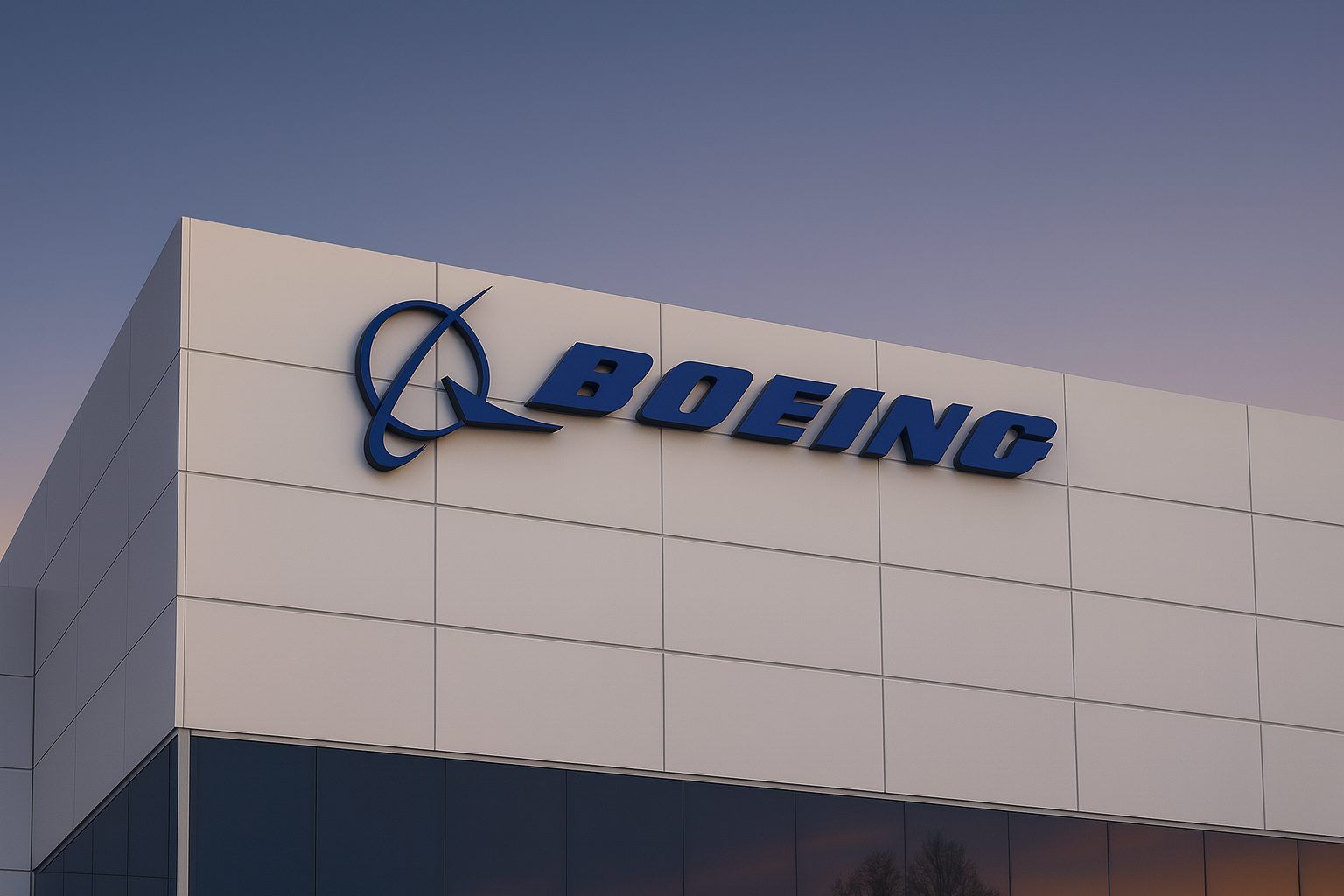Boeing (NYSE: BA) shares are trading higher this Tuesday as investors weigh a fresh batch of headlines: a widely covered “war on defects” at its 737 plant, new defense contracts, a $1 billion 787 expansion in South Carolina, a major carbon-removal deal, and a sharp scaling-back of NASA’s Starliner program.
As of mid-afternoon on 25 November 2025, Boeing stock is trading around $183 per share, up a little more than 2% on the day and near the top of today’s intraday range around $177–183. [1]
Below is what’s driving Boeing stock today, and how the latest news flow may shape the outlook for BA.
Boeing Stock Today: Price and Recent Performance
- Today’s move: BA is changing hands around $183, up roughly 2–2.3% versus yesterday’s close near $179. That puts the stock close to the upper end of today’s trading band around $177.5–$183.5. [2]
- Volatility lately: Despite today’s bounce, Boeing has had a rough month. A detailed valuation note from Simply Wall St calculates that BA has dropped almost 19% over the past month, even as its one‑year total shareholder return remains positive at about 17%. [3]
- 52‑week range: Over the last year, Boeing has traded between roughly $129 and $243, underscoring just how volatile the turnaround story remains. [4]
- Market value: At today’s price, Boeing’s market cap is sitting around $139 billion. [5]
So, what’s behind today’s rebound in BA stock?
Why Boeing Shares Are Higher Today
A real-time summary from MarketBeat points to a mix of fresh analyst support and upcoming investor access, partially offset by continued scrutiny of quality and space-program setbacks. [6]
The key bullish drivers investors are reacting to today include:
- UBS reiterating a bullish stance and high price target
- UBS analyst Gavin Parsons has reaffirmed a Buy rating on Boeing with a $275 price target, well above the current share price. [7]
- Separate coverage notes UBS recently tweaked that target down from $280 to $275 following Boeing’s big 777X charge, but the upside implied by that target remains substantial. [8]
- Upcoming CFO appearance at UBS conference
- Boeing announced today that CFO Jay Malave will speak at the UBS Global Industrials & Transportation Conference on 2 December, giving investors a near-term catalyst for updated commentary on cash flow, production cadence and quality efforts. [9]
- Positive headlines on production quality and capacity (the “war on defects,” 787 expansion, and strong defense orders – more on those below).
Counterbalancing that is negative Starliner news, but the market today appears to be focusing more on Boeing’s core commercial and defense franchises than on the troubled space capsule.
Inside Boeing’s “War on Defects” at the 737 Plant
One of today’s most widely discussed Boeing stories is a New York Times/Bloomberg‑linked feature on Boeing’s aggressive quality overhaul at its 737 factory near Seattle, often described internally as a “war on defects.” [10]
Key takeaways from that report and related coverage:
- Weekly factory stand‑downs: Every Wednesday, production on the 737 line is halted for about an hour while mechanics break into small groups to surface recurring problems and process “headaches” — from mis‑drilled holes to supplier issues. [11]
- Traveled work down ~75%: Boeing says “traveled work” (parts installed out of sequence, which can increase the risk of errors and rework) has dropped by about 75%, while the flow of aircraft through the plant has improved around 60% since April 2024. [12]
- Fewer lost tools and fuselage defects: The company reports meaningful declines in lost tools — a contributor to debris left inside finished jets — and in defects found in fuselages arriving from Spirit AeroSystems, which Boeing is in the process of acquiring. [13]
- Production ramp to 42 737s per month (and beyond): Boeing has already won regulatory approval to raise 737 MAX output from 38 to 42 aircraft per month, with plans for a series of increases that could eventually reach around 60 jets per month, assuming quality is sustained and regulators are satisfied. [14]
- Fourth 737 line in Everett in 2026: The manufacturer is preparing a fourth 737 assembly line in Everett, Washington for 2026, designed to build most models of the 737 MAX family and add capacity without overloading existing lines. [15]
Analysts quoted in the Bloomberg-linked piece note that these efforts appear to mark real progress, but also highlight that rebuilding safety culture and public trust after years of scandals will be a “long, difficult journey.” [16]
For investors, this story matters because higher, more stable 737 output is central to Boeing’s cash-flow recovery — but only if it can be achieved without further quality crises.
787 Dreamliner: $1 Billion South Carolina Expansion to Boost Widebody Output
Another fresh headline today is Boeing’s groundbreaking of a major expansion at its Boeing South Carolina (BSC) site, aimed squarely at the 787 Dreamliner. [17]
Highlights from that report:
- Boeing is investing over $1 billion across its South Carolina campuses near Charleston International Airport.
- The expansion is designed to lift 787 output to 10 Dreamliners per month by 2026, responding to surging widebody demand. [18]
- The project is expected to create more than 1,000 new jobs over the next five years and involve more than 2,500 workers and 6.2 million labor hours. [19]
- Planned additions include a new final-assembly building, parts-prep facility, vertical fin paint building, expanded interiors center, and expanded flight-line capacity. [20]
- According to the article, the 787 remains Boeing’s most successful widebody, with over 2,250 orders from 90 customers and a backlog near 1,000 aircraft, including 300+ orders booked in 2025 alone. [21]
This expansion reinforces the idea that long-haul demand is back, and that Boeing is willing to commit serious capital to widebodies even while still working through 777X delays and legacy issues.
Defense Tailwinds: New Chinook Contracts Worth Over $1.6 Billion
On the defense side, a new report from Defense Security Monitor describes how Boeing has “won big” in recent Chinook deals, padding its military backlog: [22]
- The U.S. Army is moving to “rapidly field” the CH‑47F Block II for two Combat Aviation Brigades, estimated at around two dozen helicopters across FY25–FY26 funding. [23]
- In October, Boeing reported a $461 million award for Lot 4 and 5 production of nine CH‑47F Block II aircraft. [24]
- Shortly after, it received a separate $876.4 million contract for up to 60 Block II Chinooks for Germany. [25]
- On 20 November, U.S. Special Operations Command awarded Boeing a $271.7 million contract for five MH‑47G special-operations variants. [26]
In total, that’s over $1.6 billion in Chinook-related awards since October, with analysts suggesting CH‑47 production in Philadelphia could run well into the mid‑2030s for U.S. and international customers. [27]
For BA shareholders, these deals support a steadier defense revenue base while the commercial side continues its recovery.
Climate Strategy: Boeing’s 100,000-Ton Carbon Removal Deal
Boeing also made sustainability headlines today by announcing a major carbon-removal agreement with Charm Industrial: [28]
- Under the deal, Charm will remove up to 100,000 metric tons of CO₂ from the atmosphere on Boeing’s behalf.
- The agreement is described as Boeing’s first major purchase of permanent carbon removals, and one of the aviation sector’s largest such deals to date. [29]
- Charm’s process converts agricultural and forestry residues into bio‑oil via pyrolysis, then injects that carbon-rich liquid into regulated underground storage, locking it away for centuries or more. [30]
- The partnership fits into Boeing’s “avoid first, remove second” emissions strategy, which prioritises efficiency, renewable energy, and sustainable aviation fuel (SAF) before turning to carbon removals for harder-to-abate emissions. [31]
Investors increasingly pay attention to decarbonisation credibility in long‑cycle industrial names. While this deal doesn’t move near-term earnings, it supports Boeing’s narrative as a company planning for net‑zero aviation rather than resisting it.
Space Setback: NASA Slashes Starliner Missions
The main negative overhang in the latest news cycle is NASA’s decision to cut back Boeing’s Starliner missions after the capsule stranded two astronauts on the International Space Station for roughly nine months in 2024. [32]
According to NASA and Reuters:
- The original $4.5 billion Commercial Crew contract envisioned six post‑certification crewed flights. [33]
- NASA has now reduced the guaranteed missions to four — three crewed flights and one uncrewed cargo flight — trimming the contract’s value by about $768 million to $3.732 billion. [34]
- The next mission, Starliner‑1, is scheduled no earlier than April 2026 and will fly cargo only, as engineers continue to test and certify the propulsion system after thruster issues on the 2024 crew flight. [35]
- Boeing has spent over $2 billion of its own money on Starliner since 2016, and the capsule still lags far behind SpaceX’s Crew Dragon, which has become NASA’s primary astronaut taxi. [36]
Starliner is small in dollars compared to Boeing’s commercial and defense units, but the contract reduction adds to perceptions of execution risk and reputational damage in space systems — something the stock market is still digesting.
Fundamentals Check: Q3 2025 Losses, 777X Charge and a Free-Cash-Flow Turning Point
Much of today’s commentary also draws on Boeing’s Q3 2025 earnings, reported at the end of October:
- Revenue: About $23.3 billion in Q3, up roughly 30% year‑on‑year as deliveries recovered. [37]
- Big loss driven by 777X: Boeing recorded a $4.9 billion pre‑tax charge on the 777X program, delaying first delivery until 2027 and pushing Q3 to a net loss of about $5.3 billion and a core loss per share of roughly –$7.47. [38]
- Deliveries: The company delivered 160 commercial aircraft in Q3, its best quarterly total since 2018. [39]
- Order backlog: Boeing’s total backlog sits near $636 billion, reflecting strong demand across commercial, defense and services. [40]
- Free cash flow: Importantly, Boeing generated positive free cash flow of around $0.2 billion, its first positive quarter since late 2023, aided by improved deliveries and the timing of certain payments. [41]
Subsequent monthly data show that Boeing delivered 53 jets in October, bringing 2025 year‑to‑date deliveries to 493 aircraft — its strongest pace since 2018, although still behind Airbus. [42]
These figures help explain why some analysts and credit agencies are starting to argue that Boeing’s fundamentals are turning a corner, even as the company remains deep in loss‑making territory.
What Wall Street Thinks: Valuation, Targets and Technicals
Analyst price targets and ratings
- TipRanks reports an average 12‑month price target of about $250.50 for Boeing, implying nearly 40% upside from a reference price around $179.70. The platform scores the consensus rating as “Strong Buy”, with 13 Buy, 2 Hold and 1 Sell rating in the last three months. [43]
- StockAnalysis shows a similar picture: 18 analysts covering BA with a consensus “Strong Buy” and an average target of about $239.56, roughly 30% above recent trading levels. [44]
- Beyond UBS at $275, recent updates from other major houses include targets between roughly $219 and $282 (RBC, Bernstein, Susquehanna, BofA, and others), generally with Buy or Outperform ratings. [45]
Valuation perspectives
- Simply Wall St’s narrative-based valuation framework pegs Boeing’s “fair value” around $249 per share, arguing the stock is about 28% undervalued relative to a recent close near $179.12, largely on expectations of higher 737 and 787 output and margin recovery. [46]
- That said, the same piece flags persistent production delays and still‑negative margins as key risks that could quickly undermine the bullish case. [47]
Technical backdrop
- Short‑term technical analysis from StockInvest notes that BA has been in a downtrend since late October, falling roughly 8% over the last 10 trading days and showing sell signals from both short- and long‑term moving averages. [48]
- A Seeking Alpha contributor, however, argues that Boeing’s turnaround “is real”, pointing to Q3’s 160 deliveries, improving free cash flow and easing 737 MAX production limits, and suggests chart signals hint at a potential bottom if free‑cash‑flow progress continues. [49]
In other words, Wall Street’s fundamental view is broadly bullish, but short‑term technicals still reflect the recent sell‑off and lingering skepticism.
Key Risks Investors Are Watching
Even on a strong day like today, several risks loom large over the Boeing story:
- Execution and safety risk
- The “war on defects” is encouraging, but a single new high‑profile incident could reset regulators’ and airlines’ trust. Ongoing federal oversight of 737 production and cultural reforms remain critical. [50]
- 777X delays and profitability
- The 777X’s pushed‑out entry into service (now targeted for 2027) and the $4.9 billion charge show how fragile long‑cycle widebody programs can be for margins if schedules slip. [51]
- Starliner overhang
- NASA’s reduction of Starliner missions and the move to an uncrewed next flight underscore that Boeing’s space franchise is still in damage-control mode, with uncertain economics. [52]
- Labor and supply chain
- Boeing has been managing a strike by thousands of machinists at its St. Louis defense plants, while also grappling with supplier constraints (including at Spirit AeroSystems). Sustained production increases will depend on smoothing these bottlenecks. [53]
- Macro and rate sensitivity
- Air traffic demand is strong, but higher-for-longer interest rates or a macro slowdown could pressure airlines’ ability to take delivery of new jets or finance large orders.
What to Watch Next for Boeing Stock
Looking beyond today’s move, key upcoming catalysts for BA include:
- UBS conference (2 December): CFO Jay Malave’s comments on free cash flow, 737 and 787 rate plans, 777X cash burn, and Starliner exposure could sway sentiment. [54]
- Monthly orders and deliveries updates: Investors will be watching whether Boeing can sustain 50+ monthly deliveries and execute the 737 ramp to 42 aircraft per month without fresh safety issues. [55]
- FAA and regulatory news: Any sign of additional restrictions — or, conversely, further easing of caps on 737 production — will likely move the stock. [56]
- Progress on 787 expansion and Chinook contracts: Execution on the South Carolina build‑out and military rotorcraft production could add medium‑term earnings visibility. [57]
Bottom Line on BA Stock Today
On 25 November 2025, Boeing stock is getting a lift from upbeat analyst commentary, visible progress on quality and production, and positive news in its 787 and defense franchises — even as its space program absorbs a very public setback and the 777X continues to weigh on earnings.
For long‑term investors, the Boeing story remains a high‑beta recovery trade:
- Upside case: a successful 737 and 787 ramp, sustained free cash flow, and improved safety culture that gradually restores margins and justifies today’s bullish price targets. [58]
- Downside case: another major quality incident, further 777X or Starliner setbacks, or macro weakness that slows airline demand and undercuts the recovery narrative.
Nothing in this article is financial advice, but if you’re tracking BA stock today, the key takeaway is simple: investors are rewarding signs of operational progress and analyst confidence, while keeping a wary eye on execution risk — especially in space and advanced widebodies.
References
1. www.marketbeat.com, 2. www.marketbeat.com, 3. simplywall.st, 4. www.google.com, 5. www.google.com, 6. www.marketbeat.com, 7. www.tipranks.com, 8. www.investing.com, 9. investors.boeing.com, 10. infra.economictimes.indiatimes.com, 11. infra.economictimes.indiatimes.com, 12. infra.economictimes.indiatimes.com, 13. infra.economictimes.indiatimes.com, 14. www.reuters.com, 15. infra.economictimes.indiatimes.com, 16. infra.economictimes.indiatimes.com, 17. www.constructionowners.com, 18. www.constructionowners.com, 19. www.constructionowners.com, 20. www.constructionowners.com, 21. www.constructionowners.com, 22. dsm.forecastinternational.com, 23. dsm.forecastinternational.com, 24. dsm.forecastinternational.com, 25. dsm.forecastinternational.com, 26. dsm.forecastinternational.com, 27. dsm.forecastinternational.com, 28. carboncredits.com, 29. carboncredits.com, 30. carboncredits.com, 31. carboncredits.com, 32. www.reuters.com, 33. www.reuters.com, 34. www.reuters.com, 35. www.reuters.com, 36. www.reuters.com, 37. investors.boeing.com, 38. investors.boeing.com, 39. www.ft.com, 40. investors.boeing.com, 41. investors.boeing.com, 42. www.reuters.com, 43. www.tipranks.com, 44. stockanalysis.com, 45. www.gurufocus.com, 46. simplywall.st, 47. simplywall.st, 48. stockinvest.us, 49. seekingalpha.com, 50. infra.economictimes.indiatimes.com, 51. investors.boeing.com, 52. www.reuters.com, 53. apnews.com, 54. investors.boeing.com, 55. www.reuters.com, 56. www.reuters.com, 57. www.constructionowners.com, 58. investors.boeing.com






